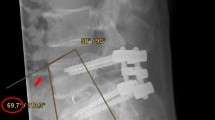Abstract
Objective
To analyse radiographic correlates for the clinical status of patients and the deformation reducibility of high-grade lumbosacral spondylolisthesis. We also clarify the clinical and radiographic correlates of a new parameter for S1 dystrophy, the “S1 index”.
Design and patients
One hundred cases of high-grade isthmic lumbosacral spondylolisthesis were reviewed. We noted the dystrophic changes in the cranial sacral endplate, and the caudal endplate of L5. The severity of the spondylolisthesis was evaluated by measuring the lumbosacral kyphosis. The clinical status and the deformation reducibility (dependent on the stiffness of the deformation) were compared with these dystrophic patterns, the sagittal slope of S1 and S2 endplates and a sacral morphological marker, the S1 index.
Results
Lumbosacral kyphosis was less severe in cases with dystrophic changes of the posterior cranial edge of S1 and/or of the posterior caudal edge of L5 but its reducibility was worse. These patients were more functionally impaired. We describe and analyse this situation as a partial lumbosacral disc failure responsible for the less severe L5 slipping. The S1 index was strongly correlated with the grade of slipping, the lumbosacral kyphosis and its reducibility. We noted the same configuration among patients with a smaller S1 index, i.e. vertical S1 and S2 vertebral bodies associated with more severe but more reducible lumbosacral kyphosis.
Conclusion
Analysing specific criteria, we think it is possible to note progressive dystrophic changes according to the natural history of lumbosacral spondylolisthesis. We think that repeated measurements of these morphological parameters in patients diagnosed with a low-grade lumbosacral spondylolisthesis could be helpful in the early detection of evolving lumbosacral kyphosis and L5 slipping.
















Similar content being viewed by others
References
van Ooij A, Weijers R, van Rhijn L. Remodelling of the sacrum in high-grade spondylolisthesis: a report of two cases. Eur Spine J 2003; 12:332–338.
Takahashi K, Yamagata M, Takayanagi K, Tauchi T, Hatakeyama K, Moriya H. Changes of the sacrum in severe spondylolisthesis: a possible key pathology of the disorder. J Orthop Sci 2000; 5:18–24.
Saraste H. The etiology of spondylolysis. A retrospective radiographic study. Acta Orthop Scand 1985; 56:253–255.
Curylo LJ, Edwards C, DeWald RW. Radiographic markers in spondyloptosis: implications for spondylolisthesis progression. Spine 2002; 27:2021–2025.
Meyerding HW. Spondylolisthesis; surgical fusion of lumbosacral portion of spinal column and interarticular facets: use of autogenous bone grafts for relief of disabling backache. J Int Coll Surg 1956; 26:566–591.
Tajima N, Kawano K, Sera K, Taguchi A, Torigoshi T, Konishi H. Posterolateral fusion of the lumbar and lumbosacral spine: a review of long term results. Nippon Seikeigeka Gakkai Zasshi 1989; 63:262–268.
Guigui P, Levassor N, Rillardon L, Wodecki P, Cardinne L. [Physiological value of pelvic and spinal parameters of sagittal balance: analysis of 250 healthy volunteers]. Rev Chir Orthop Reparatrice Appar Mot 2003; 89:496–506.
Marty C, Boisaubert B, Descamps H, et al. The sagittal anatomy of the sacrum among young adults, infants, and spondylolisthesis patients. Eur Spine J 2002; 11:119–125.
Sakamaki T, Sairyo K, Katoh S, et al. The pathogenesis of slippage and deformity in the pediatric lumbar spine: a radiographic and histologic study using a new rat in vivo model. Spine 2003; 28:645–650; discussion 650–641.
Saraste H, Brostrom LA, Aparisi T. Radiographic assessment of anatomic deviations in lumbar spondylolysis. Acta Radiol Diagn (Stockh) 1984; 25:317–323.
Saraste H, Brostrom LA, Aparisi T, Axdorph G. Radiographic measurement of the lumbar spine. A clinical and experimental study in man. Spine 1985; 10:236–241.
McPhee IB, O’Brien JP, McCall IW, Park WM. Progression of lumbosacral spondylolisthesis. Australas Radiol 1981; 25:91–95.
Marchetti P, Bartolozzi P. Le spondylolistesi: classificazione et etiopathogenesi. Prog Pat Vert 1984; 6:9.
Wiltse LL, Winter RB. Terminology and measurement of spondylolisthesis. J Bone Joint Surg Am 1983; 65:768–772.
Author information
Authors and Affiliations
Corresponding author
Rights and permissions
About this article
Cite this article
Vialle, R., Schmit, P., Dauzac, C. et al. Radiological assessment of lumbosacral dystrophic changes in high-grade spondylolisthesis. Skeletal Radiol 34, 528–535 (2005). https://doi.org/10.1007/s00256-005-0948-1
Received:
Accepted:
Published:
Issue Date:
DOI: https://doi.org/10.1007/s00256-005-0948-1




